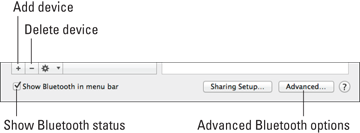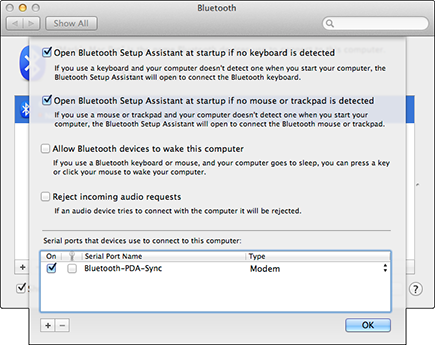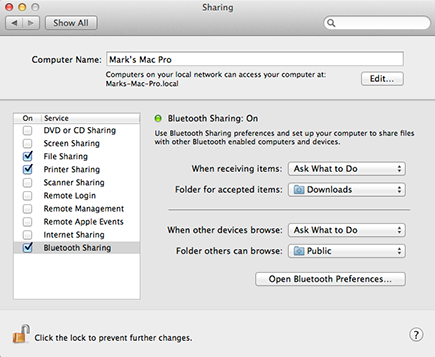Chapter 6: Putting Bluetooth to Work
In This Chapter
![]() Using Bluetooth for wireless connections
Using Bluetooth for wireless connections
![]() Adding wireless keyboards and mice
Adding wireless keyboards and mice
![]() Adding third-party utilities
Adding third-party utilities
![]() Printing over a Bluetooth wireless connection
Printing over a Bluetooth wireless connection
Time to talk cordless. Today’s MacBooks and the iMac are already pretty doggone all-inclusive because what most computers string together with cords has been integrated into the computer’s case, including the monitor and speakers. However, here’s another reason to celebrate the disappearance of cords: Every Mac model capable of running Mountain Lion includes built-in Bluetooth wireless technology, and Bluetooth is officially Hot Stuff.
For most of us, this introduces an entirely new realm of possibilities — which results in more questions. Exactly how do other wireless devices communicate with your Mac? Can you really share the data on your Mac with a cellphone or tablet that doesn’t carry a striking Apple logo?
In this chapter, I describe what’s cooking in the world of wireless devices. I don’t delve into wireless Ethernet networking between your Mac and other computers; I cover that in depth in the confines of Book VI, Chapter 3. However, I do cover the wireless Bluetooth connections that you can make with devices other than computers.
Bluetooth: What a Silly Name for Such Cool Technology
Originally, wireless computer connections were limited to IR (infrared) and 802.11b (the original Wi-Fi specification for wireless Ethernet networks). This was fine; after all, what were you gonna connect to your Mac besides other computers? Ah, but progress marches on.
Bluetooth has been incorporated into a range of peripherals and devices, including
![]() Smartphones
Smartphones
![]() Laptops
Laptops
![]() Wireless computer peripherals, such as keyboards and mice
Wireless computer peripherals, such as keyboards and mice
![]() Printers
Printers
![]() Headphones
Headphones
Mountain Lion and Bluetooth, together forever
You’d expect a modern, high-tech operating system like OS X to come with Bluetooth drivers. You’d be right, but Apple goes a step further: Mountain Lion comes with a Bluetooth pane in System Preferences and a utility application to help you get your laptop connected with the Bluetooth devices that are likely hanging out in your coat pockets.

Start by clicking the System Preferences icon on the Dock, and then click the Bluetooth icon in the System Preferences pane. From the Bluetooth pane that appears, you can
![]() Set up new Bluetooth devices. Click the Set Up New Device button (which bears a plus sign) to run the Bluetooth Setup Assistant, which configures Bluetooth devices for use with Mountain Lion.
Set up new Bluetooth devices. Click the Set Up New Device button (which bears a plus sign) to run the Bluetooth Setup Assistant, which configures Bluetooth devices for use with Mountain Lion.
Follow the device-specific, onscreen instructions to set up a number of common Bluetooth toys (including keyboards, mice, smartphones, and printers). Setup Assistant searches for your Bluetooth device and makes sure that it’s ready to party with your Mac.
 Make sure that your Bluetooth device is in range and discoverable (available for connections with other Bluetooth devices) before you run the Bluetooth Setup Assistant. Check your user manual to determine how to set your Bluetooth device as discoverable, and make sure that you’re about 20 feet (or fewer) away from your Mac.
Make sure that your Bluetooth device is in range and discoverable (available for connections with other Bluetooth devices) before you run the Bluetooth Setup Assistant. Check your user manual to determine how to set your Bluetooth device as discoverable, and make sure that you’re about 20 feet (or fewer) away from your Mac.
 I recommend that you enable the Show Bluetooth Status in the Menu Bar check box. If you’re using a MacBook, the Bluetooth menu lets you conserve power by turning off your Bluetooth hardware until you need it. You can also conveniently toggle your Mac’s discovery status as well as set up a device or send and browse files. (You can even see what devices are connected to your Mac with the click of a menu icon. ’Nuff said.)
I recommend that you enable the Show Bluetooth Status in the Menu Bar check box. If you’re using a MacBook, the Bluetooth menu lets you conserve power by turning off your Bluetooth hardware until you need it. You can also conveniently toggle your Mac’s discovery status as well as set up a device or send and browse files. (You can even see what devices are connected to your Mac with the click of a menu icon. ’Nuff said.)
![]() Configure Bluetooth connections. Click the Advanced button to create, remove, enable, or disable your Bluetooth connections, using them as virtual serial ports (for the simple data transfer) or virtual modems (for bidirectional transfers, such as using an Internet connection through a Bluetooth smartphone).
Configure Bluetooth connections. Click the Advanced button to create, remove, enable, or disable your Bluetooth connections, using them as virtual serial ports (for the simple data transfer) or virtual modems (for bidirectional transfers, such as using an Internet connection through a Bluetooth smartphone).
These openings to the outside world are presented as individual connections in the Serial Port list, and you can toggle them on and off individually. You can also specify whether a Bluetooth port is encrypted. Figure 6-1 shows an active Bluetooth virtual modem that’s set up to allow my Mac Pro to sync up with my Palm Pilot, using the Bluetooth-PDA-Sync service.
Figure 6-1: You can add, delete, enable, or disable Bluetooth ports from the Advanced sheet.

The other Bluetooth resource that you can use is the stand-alone application Bluetooth File Exchange. (Yes, you can call it BFE if you like. I do whenever possible.) You have to launch BFE the old-fashioned way; it’s available from the Utilities folder within Launchpad. Launching the application presents you with a file selection dialog in which you choose the file(s) you want to send to the connected Bluetooth device. You can also elect to browse the files on a networked Bluetooth device so that you can see what the owner of that device is offering. (Note, however, that BFE doesn’t work with iPhones, iPads, or the iPod touch.)
You can also set up your defaults for file exchanges from the Sharing pane in System Preferences. While you’re in the Bluetooth pane, click the Sharing Setup button, and System Preferences whisks you directly to the Sharing pane. Select the Bluetooth Sharing check box (left side) to display the settings shown in Figure 6-2. Here, you can control what Mountain Lion does when you receive files or Personal Information Manager (PIM) data with BFE. For instance, with these settings, Mountain Lion can
![]() Prompt you for permission to receive each file or PIM item
Prompt you for permission to receive each file or PIM item
![]() Accept all files and PIM items without restriction or prompting
Accept all files and PIM items without restriction or prompting
![]() Save all incoming files and items to the folder that you specify
Save all incoming files and items to the folder that you specify
![]() Prompt you for permission when other devices want to browse your Mac
Prompt you for permission when other devices want to browse your Mac
![]() Offer only the files and items in the folder that you specify when other Bluetooth items browse your Mac
Offer only the files and items in the folder that you specify when other Bluetooth items browse your Mac
Figure 6-2: Configure file exchanges in System Preferences.

![]() When Receiving Items: Stick with Ask What to Do so you can know when someone is sending you something.
When Receiving Items: Stick with Ask What to Do so you can know when someone is sending you something.
![]() Folder for Accepted Items: I recommend that anything you receive be saved in your Downloads folder.
Folder for Accepted Items: I recommend that anything you receive be saved in your Downloads folder.
![]() When Other Devices Browse: I prefer to authorize other devices when they attempt to browse my Mac, so I leave this set to Ask What to Do.
When Other Devices Browse: I prefer to authorize other devices when they attempt to browse my Mac, so I leave this set to Ask What to Do.
![]() Folder Others Can Browse: If you allow a device to browse, they can only access the contents of your Public folder.
Folder Others Can Browse: If you allow a device to browse, they can only access the contents of your Public folder.
However, feel free to adjust, enable, and disable to your heart’s content.
Adding Wireless Keyboards and Mice to Your Mac
The current crop of Macs arrives at your doorstep with full wireless support: Apple includes both internal Bluetooth hardware and internal AirPort Extreme wireless hardware. You can indeed work keyboard and mouse magic from across the room from your Mac, with a wireless keyboard and mouse — either the wireless keyboard and mouse (or trackpad) that come with specific Mac models, or models you can buy on your own. Even if you’re a MacBook owner, perhaps you just want a full-size keyboard and external pointing device to use when you’re working from your home or office.
A number of wireless Bluetooth keyboard/mouse packages are on the market, and any one of ’em should work fine with your Mac. In fact, you can buy Apple’s wireless Bluetooth keyboard and mouse separately, for about $140. Other offerings from Logitech and our old buddy Microsoft run about the same amount.
When shopping for a Bluetooth keyboard/mouse desktop, keep these facts in mind:
![]() Some keyboards are created more than equal. Many of today’s third-party keyboards are encrusted with extra function buttons that do everything from opening your e-mail application to searching your kitchen cabinets for another can of spray cheese.
Some keyboards are created more than equal. Many of today’s third-party keyboards are encrusted with extra function buttons that do everything from opening your e-mail application to searching your kitchen cabinets for another can of spray cheese.
 I like these programmable function keys because they’re handy for bringing up your favorite applications with a single keystroke while you’re relaxing 20 feet away. I recommend that you look for the keyboard in your price range that offers the most programmable keys.
I like these programmable function keys because they’re handy for bringing up your favorite applications with a single keystroke while you’re relaxing 20 feet away. I recommend that you look for the keyboard in your price range that offers the most programmable keys.
![]() Rodents crave energy. If the wireless mouse or trackpad comes with its own recharging stand, that’s a big plus. Depending on how much you use your laptop, a pointing device that runs on standard batteries can go through a set in as little as a month’s time! (Not surprisingly, many computer owners use rechargeable batteries in their wireless mice.) Some wireless mice and trackpads (including those from Apple) feature an on/off switch to help conserve battery power.
Rodents crave energy. If the wireless mouse or trackpad comes with its own recharging stand, that’s a big plus. Depending on how much you use your laptop, a pointing device that runs on standard batteries can go through a set in as little as a month’s time! (Not surprisingly, many computer owners use rechargeable batteries in their wireless mice.) Some wireless mice and trackpads (including those from Apple) feature an on/off switch to help conserve battery power.
![]() Wireless doesn’t always mean Bluetooth. Just because a keyboard or mouse is wireless doesn’t automatically make it a Bluetooth device. Plenty of wireless RF (radio frequency) devices are out there, too. These toys need their own transmitters, which are usually USB-based as well. Therefore, read the box or technical specifications carefully to make sure you’re buying Bluetooth.
Wireless doesn’t always mean Bluetooth. Just because a keyboard or mouse is wireless doesn’t automatically make it a Bluetooth device. Plenty of wireless RF (radio frequency) devices are out there, too. These toys need their own transmitters, which are usually USB-based as well. Therefore, read the box or technical specifications carefully to make sure you’re buying Bluetooth.
![]() Wireless stuff isn’t self-cleaning. Sure, your new wireless keyboard and mouse can hang out with you on the sofa, but that doesn’t mean they’re happy sharing your nacho puffs and grape soda. Look for an optical mouse that doesn’t use a ball, and check whether a prospective keyboard or trackpad can be easily cleaned and maintained before you buy it.
Wireless stuff isn’t self-cleaning. Sure, your new wireless keyboard and mouse can hang out with you on the sofa, but that doesn’t mean they’re happy sharing your nacho puffs and grape soda. Look for an optical mouse that doesn’t use a ball, and check whether a prospective keyboard or trackpad can be easily cleaned and maintained before you buy it.
Most Bluetooth devices are installed and controlled through the Bluetooth pane in System Preferences. However, wireless keyboards, trackpads, and mice are a special case because they’re installed via the Bluetooth controls in the Keyboard, Trackpad, and Mouse panes. (Geez, those Apple designers give you a dozen roads to the same spot on the map, don’t they?) You can read more about each of these System Preferences panes in Book II, Chapter 3.
The Magic of Wireless Printing
To your Mac, a wireless Bluetooth printer might be just another Bluetooth connection, but to you, it’s the very definition of convenience, especially if desk space is limited next to your Mac. Just set that paper-producing puppy up anywhere in the 30–40 foot range, plug it in, set up the printer in Mountain Lion, and let ’er rip.
You have two options when installing a Bluetooth printer:
![]() Whenever possible, use the printer manufacturer’s software. A printer might require a driver that a typical Bluetooth device doesn’t need.
Whenever possible, use the printer manufacturer’s software. A printer might require a driver that a typical Bluetooth device doesn’t need.
![]() You can usually successfully set up a printer via the Bluetooth Setup Assistant, which you can run from the Bluetooth pane of System Preferences (as I discuss earlier in this chapter):
You can usually successfully set up a printer via the Bluetooth Setup Assistant, which you can run from the Bluetooth pane of System Preferences (as I discuss earlier in this chapter):
1. Make sure your printer is set as discoverable.
Check your printer manual to determine how to switch your printer to discoverable mode. This mode allows other Bluetooth devices within range (including your laptop) to recognize and make a connection to your printer.
2. Click the Set Up New Device button.
3. Choose the printer from the list.
4. Follow the onscreen instructions.
Luckily, after you successfully set up a Bluetooth printer, you can just press ![]() +P to open the Print dialog and choose that printer from the Printer pop-up menu. No big whoop . . . and that’s the way it should be.
+P to open the Print dialog and choose that printer from the Printer pop-up menu. No big whoop . . . and that’s the way it should be.
